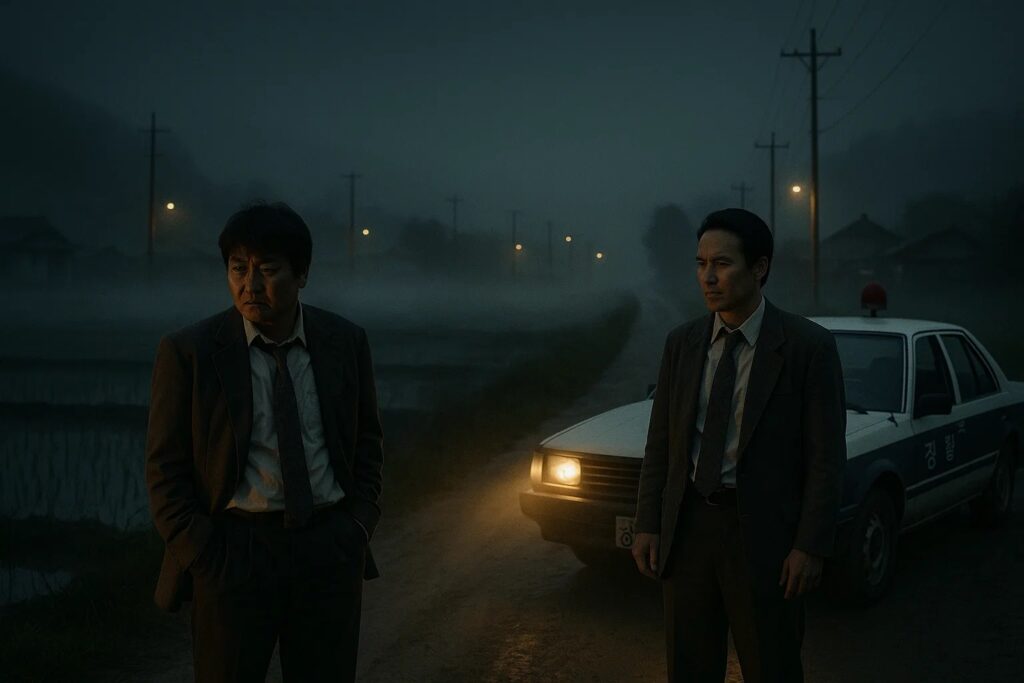
Let’s break this down the way I like to talk movies, insightful but straight to the point. We’re going to dive into the true story behind Memories of Murder, explore how Bong Joon-ho turned it into a masterpiece, and see what happened in real life to the killer who haunted an entire nation for decades. Buckle up, because this one’s not just cinema. This is history with blood under its fingernails.
The True Story Behind Memories of Murder
Back in the mid-1980s, South Korea was under military rule. Political tension was thick in the air, but what was happening in the rural province of Hwaseong was something else entirely. Between 1986 and 1991, at least 10 women were brutally murdered. The victims ranged in age from teenagers to women in their seventies. All were raped, strangled, and left in fields or ditches. It was the country’s first known case of serial killing, and it terrified people across South Korea.
This is the foundation for Memories of Murder. Bong Joon-ho didn’t invent the horror. He pulled it straight from the case files and the collective fear that gripped Korea.
What made the case so infamous was not just the brutality, but the incompetence and desperation of the police. Hundreds of suspects were interrogated. Over 20,000 people were questioned. More than 40,000 officers were mobilized across the years. And yet, for decades, the killer remained unidentified.
That’s where Bong Joon-ho steps in.
Is Memories of Murder Based on a True Story?
Yes, absolutely. The film doesn’t hide it either. Bong Joon-ho and co-writer Shim Sung-bo built the script directly around the Hwaseong murders. They changed names and dramatized some events, but the crimes, the atmosphere, and the haunting uncertainty? All true.
Even the movie’s infamous ambiguity, the way it ends with no clear answers, wasn’t a screenwriting trick. That was reality. In 2003, when Memories of Murder was released, the real killer had not been caught. The film’s bleak conclusion reflected the frustration of a case that seemed destined to remain unsolved.
For audiences unfamiliar with the history, it felt like a gutsy storytelling move. For Koreans, it was a mirror of real despair.
Did They Find the Killer in Memories of Murder?
In the film, no. That’s what made the ending so haunting. Song Kang-ho’s character stares into the camera during that final scene, his eyes searching, maybe even accusing the audience. It’s a gut punch because the real case was unsolved at the time.
But here’s the twist: in 2019, nearly two decades after the film, authorities finally identified the killer through modern DNA analysis. His name? Lee Choon-jae. And the reality of his crimes was somehow even more chilling than the movie suggested.
Lee was already serving a life sentence for the murder of his sister-in-law in 1994. When DNA from the Hwaseong cases was re-tested, it matched him. During questioning, Lee confessed to not just the ten murders tied to the Hwaseong case, but more than a dozen other crimes, including rapes and assaults. It was a revelation that shocked the country again, this time with closure mixed with rage.
So while Memories of Murder left us hanging in the early 2000s, real life gave us an answer almost twenty years later.
Bong Joon-ho’s Vision: Why the Film Still Resonates
Here’s the thing about Memories of Murder: it’s not just a true-crime retelling. Bong Joon-ho took a national trauma and turned it into something layered, cinematic, and devastatingly human.
1. The Atmosphere
The film bathes you in rural South Korea of the late ’80s, muddy fields, dim interrogation rooms, and cigarette smoke hanging in the air like a constant reminder of decay. Bong doesn’t make it glossy. He makes it feel uncomfortably real, like you can smell the damp earth where the bodies were found.
2. The Detectives
Song Kang-ho and Kim Sang-kyung play detectives Park Doo-man and Seo Tae-yoon, two men with opposite methods. Park is the small-town cop who thinks he can spot guilt just by looking at someone. Seo is the outsider from Seoul, by-the-book, scientific, frustrated with the chaos around him. Watching them unravel as the case slips away isn’t just great acting, it’s a reflection of what really happened to the police at the time.
3. The Theme of Failure
Unlike most Hollywood crime thrillers, Memories of Murder doesn’t end with justice served. It ends with failure. Failure of the police, failure of the system, and failure to protect the women of Hwaseong. This is why the movie lingers. It doesn’t give you the comfort of closure. It forces you to sit with the horror of uncertainty.
Is Memories of Murder Unsolved?
This is where history and cinema diverge. When the movie premiered in 2003, the murders were unsolved. That ambiguity gave the film its chilling power.
But in real life, the mystery broke in 2019 when Lee Choon-jae was confirmed as the killer. By then, the statute of limitations had expired, meaning he couldn’t be prosecuted for the Hwaseong murders. Imagine that: the man confessed to killing, but the law couldn’t punish him for most of those crimes.
That legal loophole added another layer of tragedy to the story. It also reignited discussions in Korea about how justice is served, and how sometimes, justice never arrives.
How Reddit and True Crime Fans Kept the Story Alive
If you’ve ever scrolled through Reddit threads on true crime, you know how obsessed people get with unsolved mysteries. Memories of Murder found new life on platforms like Reddit, where fans dissected every detail of the film and compared it with real case files.
Questions like “Was Memories of Murder a true story?” or “Did they ever find the killer?” kept the discussion alive for years. When the 2019 breakthrough hit the news, Reddit lit up like a crime scene board. For many international fans, it was their first time realizing just how close the film was to reality.
Bong Joon-ho’s Career Boost
Let’s not forget what this film did for Bong Joon-ho. Before Parasite took home the Oscar, before he became a global name, Memories of Murder was his calling card. Critics praised the way he blended genre with social commentary. It wasn’t just about a serial killer, it was about South Korea in the late ’80s, about the police state, about ordinary people crushed by forces bigger than them.
In hindsight, you can see the DNA of Parasite in this film: the mix of dark humor, bleak reality, and sharp social critique. Memories of Murder wasn’t just a thriller. It was a warning that sometimes, the real horror isn’t the killer, it’s the society that enables him.
Why the Film Still Matters Today
Even with the case “solved,” the film hasn’t lost its punch. If anything, knowing the killer was eventually found makes that final stare into the camera even more haunting.
For international audiences, it’s a lesson in how true crime stories transcend borders. You don’t have to be Korean to feel the dread of a predator who slips through the cracks. You don’t have to live in Hwaseong to understand what it means when the system fails its people.
For film lovers, Memories of Murder is a masterclass in tone, pacing, and character. It proves you don’t need Hollywood gloss to make a story unforgettable. Sometimes, you just need honesty, patience, and a director brave enough to end on silence instead of resolution.
Memories That Haunt
So, is Memories of Murder a true story? Yes. And it’s one of the rare times where the real story might be even darker than the film. Bong Joon-ho gave us a masterpiece that captured the futility and despair of an unsolved case. Then, decades later, reality gave us a name, a face, and a confession. But even with that knowledge, the movie hasn’t lost its sting.
If anything, the story of Lee Choon-jae makes the film more terrifying, because it reminds us that the monster wasn’t just an idea, he was real, and he lived among people for years without being caught.
That’s why Memories of Murder isn’t just one of the greatest crime films ever made. It’s a cinematic grave marker for the victims who never saw justice, and a reminder that sometimes, the scariest stories are the ones that really happened.

I am Jeremy Jahns – Your Cinematic Explorer
Immerse in movie reviews, Hollywood insights, and behind-the-scenes stories.